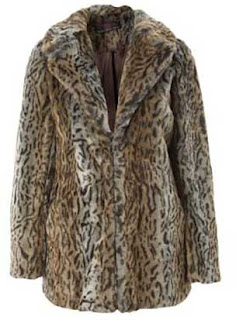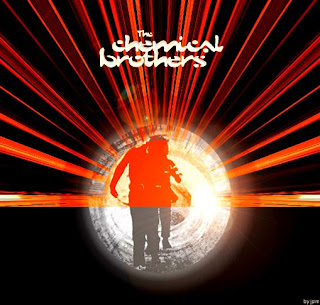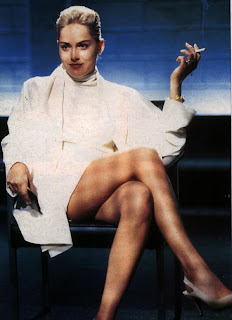- This opens with the distributor for approximately 2 seconds and quickly fades into the trailer alongside a chiming xylophone sounds - adds a mystical feel referring to the narrative and genre of the film
- Fades onto a confused man which adds to further questioning references - lingers for a few seconds then fades to black and onto a confused woman. Repetition of confusion follows, as shown through a befuddled individual, to a slow fade to black, followed by further more confused people. Alongside the questioning music, which compliments each other well. A man is also shown with binoculars, which has watchful attributes, adding to further questionings within this film
- Art is displayed in the background: arty feel with a French film, which is associated with one another. This adds a stereotypical feel. From this, other settings are revealed behind these 'confused individuals', such as a mass amount of cigarettes (hinting at a shop?) and a large building that may represent a train station
- These images last for approximately 2-3 seconds each which emphasizes a heightened pace, although the use of non-diegetic music again adds an instant slow-pace of the trailer, not breaking through too quickly - mainly audibly
- Further images of people follow, with the pace fastening e.g. from 2 seconds to the last close-up shot being only 0.5 to 1 second. This allows the audience to recognise the plot of the trailer is opening as the pace introduced further areas.
- A typical American's male voice opens the narrative, asking the audience: 'do you know what these people have in common?' This lures in the audience allowing them to join in with the plot rather than just view the film.
- From this, I have acknowledged that an American voice for a French film has been used: a typical convention, highlighting this is an American advert. The use of a male narrator could rebel from the female audience, which lessens attention upon gender bias. On top of this, I have noted that the previous trailers that I have analysed also follow the convention of using a male narrator, both American with a deep, bold voice. As this French film has been portrayed in an American style, it has been re-worked and stylized for the particular audience. However, I shall next focus upon an English film, and view whether any variables follow alongside a different country choice
- The use of including the actors with the narrator adds to further joining in, highlighting that this is a friendly, comforting film. This can be found with footage of a child actress, as she replies to the narrator's previous question with a shaking of the head whilst maintaining eye-contact with the camera. This adds to a postmodern feel, with the audience recognising the use of technology and that this is in fact a film. This compliments the genre, noting that this is not a serious film and has a comic feel.
- The introduction of the characters in the intro is quite fast, although the slow pace of the edits (as shown through the fades to black) softens the speed, therefore not rushing the plot too thoroughly and relaxing the audience
- A graphic match from the little girl to a cut to an adult woman is positive, as we understand they are a transformation in age; this is the same female, but grown up (this is obvious through her eyes, face shape and short, square-like haircut) This highlights that we may follow her life-story, as she transforms from a child to a woman - further hinting at the plot of the movie
- The narrator answers our questions, stating 'This is Amelie' in respond to the shot of the grown up woman. A fast-tracking shot of the woman falls alongside this, first revealing her from a medium-shot to close-up of her face. This is in contrast to the previous shots, which are slow and dream-like in response to the music. However, this instantly opens up the trailer, heightening the speed. Alongside this, the jingle sounds heard before continue but with a lessened gap between each sound, complimenting the speed of the shot. This tells the audience that excitement will follow in the trailer, answering their information needs upon the plot.
- This Amelie also matches the camera lens with her eyes, highlighting further acknowledgment of the audience. Through this use of repetition, we understand the character may allow the viewer to join in, may interact with them or possibly even talk to them throughout the film. This would compliment the previous 'fun' feelings of the film
- A cut follows an establishing shot, which reveals large windows within a large building. A thunder and lightning sight is shown here. The use of this setting could be significant, as well as the use of the thunder sound highlighting possible negatives here. The thunder could also highlight disequilibrium, therefore being a change in the trailer; it may highlight the change of narrative and busy shots that are to come, heightening the audience's expectations. A large clock can be seen in this clock, referring to the previous acknowledgment of it being a train station: could this be the significant setting?
- Three quick paced shots follow. They reveal Amelie kneeling down, then a crab shot from a crack in the wall with a box, and then her picking up the box through shot reverse shot. The camera then focuses on the box, revealing this may be a significant part of this film; the prop may reveal areas of the plot, be an importance to somebody, etc...
- The narrator reveals more areas of the plot, showing the box inside the hand of a man in a telephone box - referring to setting, more characters, meaning and symbols, etc... - as well as him stating: 'childhood treasure', which possibly reveals what the box in fact is
- The use of reaction shots and POV shots follow, upon people's feelings towards this box and other areas of the film. In relation to the start of the trailer, they also appear dazed and confused. This furthermore allows us to follow the film. A shot reverse shot shows the man's face as he opens the box, followed by a bewildered appearance. An edit divides his shocked reaction, with a 'flash' feel - this could represent a flash of memory, shock or acknowledgement from opening the box
- Romance connotations are hinted at, with a shot of Amelie looking to the side (which lasts approximately 2 seconds) followed by a shot of a male appearing to look in the opposite direction, therefore diverting his gaze at her. The music signifies this, with gentle musical tones which set a peaceful setting, but also have a French feel, therefore reminding us of the setting as well as concentrating on the storyline
- The next cut is a long shot of both the male and Amelie being pulled together into the same shot, although with a noticeable distance, highlighting possible problems within their romance settings. The setting is clear, as shown through food advertisements and the tables, showing a cafe. Amelie is in uniform, which reveals her occupation within the plot
- A reaction shot shows the man, furthermore appearing confused, which follows a cut of Amelie looking sad, and appearing the melt. The use of animation here therefore adds to further entertaining connotations, although displayed in a dry manner due to her sad appearance. In contrast to the previous entertaining values, this film is represented with a mixture of emotions
- The camera pans down to the 'melting Amelie', which shows her dissolve into a splash of water. This could highlight disappearances and typical emotion aspects (people feeling like they want to vanish when they feel sad). The water quickly fades into writing, with the background fading to black. The water has metamorphosed into orange, spiky font, reading the director and a previous film - therefore recognising past elements, which may have been put into this feature. This is an advertisement ploy, as if previous audiences enjoyed the film told, they may enjoy 'Amelie' too
- Sharp fast-paced shots follow, revealing different sides to the supposed characters shown. A black and white shot shows Amelie dressed up, furthering the mystical feel, with the male 'lover' character being presented with an extreme-close up again. Further shots follow, such as an elderly man stereotypically doing the gardening, Amelie smiling, etc... This achieves a trailers need for pace, beginning with a short, slow introduction followed by a rushed need to reveal the plot. As well as represented through the fast-paced images, the music also contributes to this, as revealed through the violin, high-pitched sounds, which fasten in pace and become almost unrecognisable through the distorted use of clashing violins
- The use of fast-paced shots works well to fasten the pace alongside the music. These correlate well to make the trailer far more entertaining. In relation to this, the repetition of the previous flash and a fast-paced editing to show people moving at a higher, unrealistic speed which fastens the pace further. As this is an actual clip from the film, we also acknowledge that the narrative may be pushed forward throughout. This adds further to the narrative, but in this point to the speed
- Answers are told in relation to the previous shots, such as Amelie dressed in costume again, revealing a ripped up photo of this image, as well as her undressing - highlighting the purpose of this costume was through taking a photograph. This could add to a motif of the film
- As the pace fastens, so does the music. Further shots are used, approximately lasting for 0.5 seconds each, as well as the use of fast-paced editing to fasten the speed and the excitement of the trailer. Further violins are brought into the soundtrack, distorting a rushed but peaceful sound. It is rather romantic but rushed, also relating to the plot and the images previously shown
- The shots shorten further as the finale of the trailer succumbs, almost aiming to rush in as much information as possible within a short time. The music follows this, fastening further until it denotes a 'squiggle' like sound. The shots continue to be shorter and faster, until an close-up shot of Amelie mirroring the introduction shot of her is shown, although this time in different dress and outside - showing a 'brightening' ending for the film, as shown through the trailer. This shot lingers for approximately 2-3 seconds, which hints it may be the lasting shot. She is also looking at the camera - and therefore the audience - again, but this time she smiles in a shy and secretive manner. This relates to the questioning theme throughout the trailer, and her smile almost says, 'watch this film to find out'.
- A cut follows, concluding the trailer, of a black background (likewise to the director title beforehand) with the same spikey, orange font. This time however, it simply reveals the title of the film - 'Amelie'. The music is previously distorted, but as this title wipes onto the screen, the violins halt to an abrupt stop, adding a bold effect that would attract the audience.
- This title then fades after 2 seconds onto a further image of Amelie asleep. A slow piano sounds can be heard, adding a lullaby, peaceful feel which may show the emotional side of the film. Further animation can be found with a cut-in to Amelie's lamp, which shows an ornament pig reaching out to turn off the lamp. This relates to the 'melting' animation beforehand, hinting at cartoon areas within the movie. However, as shown next to a sleeping Amelie, this could suggest her imagination as she sleeps, which concludes nicely to the bright, fluorescent colours and variation of both events, people and situations as shown previously throughout the entire trailer.
- A final piano key is played, being of the last sound of the trailer, as the image fades into a black background again (SVS) but this time highlighting background info of the film (e.g. the director, producers, further actors, etc...) which is shown in tiny orange writing again (highlighting intertextuality) from this we can also view the distributor logos in the corners, as typical convention, which needs to be provided for the film to even take place

• This is a French poster promoting the film, ‘Amelie’. It is ideal for me as I have only focused upon American posters previously through my research, so it will be interesting to acknowledge any differences with a different foreign advertisement
• In relation to the font, most of the writing featured on the poster features the same format, which portrays slit-like, stretched words. At the top of the poster, the two main actors’ names are shown, with one on the right and one on the left. These take up about a tenth of the poster vertically, showing they may not be the main importance but their bold white lettering makes them an essential read. Approximately a third of the poster between them is free, although in small writing – slightly above their names – features the ‘[distributors] presents’ typical logo.
• Approximately 7/10ths down of the poster is the title of the film. This has been shown in yellow, so it stands out further in comparison to the other colours featured on the poster. Shown in French, it reads: ‘The fabulous Destiny Amelie’ . This clearly presents the film’s title and is an interesting way to introduce the character. The actual title of the film ‘Amelie’ has been shown in larger font, therefore noting that this is the main focus. Underneath the bold title, in approximately the same font as the actors titles, is the director. Therefore, the individual names that are important for this film’s advertisement are all equal, and also in white font, to enlighten them in comparison to the other areas featured.
• Below this, also in white writing, is the information for the background of the film, the distributors, who contributed to its making, etc... This is not as important to a mainstream audience, to who may read this if they wish but it is not clearly highlighted for an eye-glance. I have noticed this throughout the other posters I have viewed, therefore making me acknowledge this convention. This area takes up about 1/10th to 2/10th’s of the poster
• There is only one image on the poster, to which is a bold photograph of a female, who is presumably Amelie due to this being a popular French female name. Three colours are featured on the image, noted as black, white and red – this could connote she is a dull, boring individual, although the other colours of the poster contrast away from this idea due to them being bright. Although the colours used together are dull, she surprisingly stands out due to her alarming pale complexion – which is snow white – as well as her haircut, being short but choppy with an obvious fringe. The red colours shown add colour to her almost boring persona, with a rose-red top and matching lipstick to match. However, the other colours shown alongside this highlights her image. Her eyes are striking due to being quite hollow black, which connotes negativity but her smile defers from this and she appears both shy and cute. Therefore, ignoring the dull colours, the audience are made to feel happy towards this character. This appearance of her is likewise to the one featured within the film, being of our first introduction to her adult persona. Therefore, intertextuality can be found here, being of another introduction to her in this costume.
• This image covers the core of the photo, both in the middle and sideways. There is a slightly further gap to the right in comparison to the left, however, which may be open due to open interpretations.
• The bottom of Amelie’s persona is black, which fades into a black background for the white information at the bottom
• The background contrasts completely from the other colours highlighted; it is green. However, it is quite blotchy and the green, almost appearing smoke-like, which adds a mystical effect. This works well alongside the jingle sounds featured on the trailer, as a mystical sense can then be found again, complimenting the plot of the film. The colour is gas-like, which may contribute to her bizarre imagination featured in the trailer (e.g. the animated pig whilst she sleeps) A drug hint may even be contributed to the colour, but no hint of this can be shown within the trailer. Overall, the colour is a bizarre use and doesn’t appear positive, but in comparison to the remaining images and colours shown on the poster, it combines well – furthering the mystical, bizarre theme.
Magazine analysis for 'Amelie':




































